NETWORKS
Gerard Borg
ENGN4545
2007
Networks
|
Here we briefly look at some common ways to describe linear
networks. Networks are referred to as linear if the components which
comprise them have a linear relationship between voltage and
current. An immediate consequence of this is that the variation of
voltage between two nodes in the network with the current into those
nodes must be linear (could it ever be quadratic?). It does not
matter whether there are transistors and reactances or whatever in the
network as long as we confine ourselves to a range of voltage and
current oscillation amplitudes for which all components behave
linearly.
1. THEVENIN AND NORTON EQUIVALENT CIRCUITS. For example consider the following linear blackbox
with some wires hanging out...  If resistors of various values are connected across
the output terminals, then the variation in the magnitude of the
current versus voltage would look as on the graph at the right.
Clearly, for all we care, the blackbox circuit really looks like the
following, 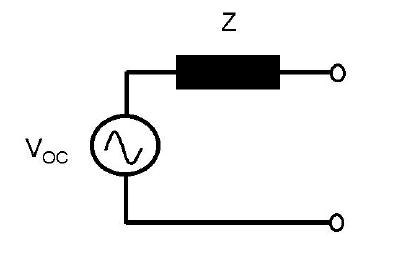 This is
the Thevenin (pronounced in between 'Tayvna' and 'Tevnang') equivalent
of the black box network. It behaves as a voltage source of value
equal to the open circuited voltage of the network and an output
impedance equal to that obtained between the terminals with the
internal voltage (and current) sources suppressed. An obvious variation is the Norton equivalent as
follows, 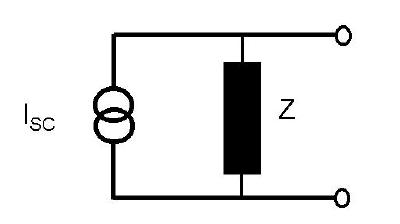
Ex.8. Prove that maximum
power is transferred from the source to the load when the output
impedance is equal to the complex conjugate of the load
impedance.
The principle proven here is the principle of matching a source to a
load. Thus we see that matching is a question of maximum power
transfer to the load. A much bigger constraint on matching whenever a
transmission line is involved is that the load and source impedances
in question must also equal the characteristic
impedance of the transmission line in order to avoid the
reflection of radio frequency power back from the load to the source.
Since the latter is usually about 50 - 300Ω s, in practice we try
to match everything to this value. The impedance on which a
particular device operates is an important parameter in the
specification of an RF circuit.
2. S-PARAMETERS
One method of characterising linear devices that
permits practical measurements to be performed, are the
S-parameters. These are easy to understand if you have already read
about reflection of transmission line
waves. The following shows the idea. Here I have drawn a four port
device "X" under test. It is driven from a terminated source and feeds
a load. In practice, this load does not have to be at the
characteristic impedance of the system. For example, imagine that the
device under test were a transistor coupling power to the load. The
load would be chosen with an impedance equal to the complex conjugate
of the output impedance of the transistor.
The source sends a signal a1 toward X. In general we would
measure a reflected signal b1 return from X. The rest of
the signal a1 is transmitted by X and partly becomes
b2 which propagates toward the load. The signal
b1 arises partly because X is not terminated at its input
and partly because the load ZL is not a proper termination.
In the latter case a reflected signal a2 results which is
then transferred back to the input of X and contributes to
b1. Similarly part of a2 is reflected at the
output and contributes to the rest of b2.
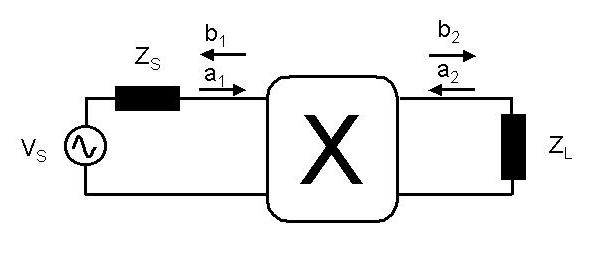
The S-paramters are then defined by the following,
b1 = S11a1 + S12a2
and,
b2 = S21a1 + S22a2
S11 is the input reflection coefficient or "return loss",
S12 is the reverse transmission coefficient, S21
is the forward transmission coefficient and S22 is the
output reflection coefficient. The advantage of the S-parameters is
the ease with which they can be measured since all measurements
involve terminated lines.
S11 = (b1/a1)|a2=0. VIZ
let ZL = Z0 and measure the reflection
coefficient. Thus S11 is the usual reflection coefficient.
S21 = (b2/a1)|a2=0. VIZ
let ZL = Z0 and measure the ratio of the
transmitted to the incoming signal. Therefore, the insertion loss
(gain) is S21
S22 = (b2/a2)|a1=0. VIZ
swap the source and ZL, let ZL = Z0
and measure the reflection coefficient.
S12 = (b1/a2)|a1=0. VIZ
swap the source and ZL, let ZL = Z0
and measure the ratio of the transmitted to the incoming signal.
|
3. Y-PARAMETERS
An alternative way to describe a four port network is in terms of the
y-parameters. These are admittance parameters and will become useful
when we try to analyse the performance of transistors. The figure
shows the sense of the voltages and the currents used in their
definition.
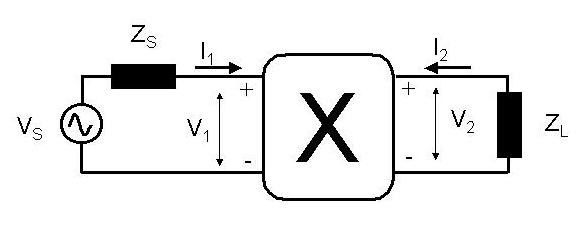
The y-parameters are given by.
I1 = yiV1 + yrV2
I2 = yfV1 + yoV2
where yi is the short circuit input admittance,
yr the short circuit reverse-transfer admittance,
yf the short circuit forward-transfer admittance and
yo the short circuit output admittance.
For future reference, the y-parameters can be related to the
S-parameters by the following formulae.
yi = ((1 + S22)(1 - S11) +
S12S21)/det/Z0
yr = -2S12/det/Z0
yf = -2S21/det/Z0
yo = ((1 + S11)(1 - S22) +
S12S21)/det/Z0
det = (1 + S11)(1 + S22) - S21S12
4. A TECHNIQUE FOR ANALYSING LINEAR CIRCUITS OF ARBITRARY
COMPLEXITY
Using the S-parameters, one is equipped to do RF circuit designs based
on transistor data sheets. However there is now a dilemma. Even the
simplest common emitter amplifier presents an horrendous design
project for a small signal transistor like the one shown above due to
the quantity of algebra involved. Repeat this hundreds of times a year
and before you know it, months have been squandered with pen and
paper. One alternative, which in the nearer to longer term should be
pursued, is to become acquainted with SPICE (Simulation Program with
Integrated Circuit Emphasis) or PSPICE (the PC windows version). As
the name suggests, SPICE has a large amount of support for specific
transistors.
I now present a MATLAB program model that can be
used to analyse a linear circuit with a single current (or voltage)
source. We derive the model in order to treat specifically four port
devices which have been characterised in terms of the
y-parameters. However we will also look at the case of routine four
port devices such as transformers and transmission lines. The obvious
up-side is that it will free you from the algebra and may also teach
you something about circuits. However you may also have a preference
for some commercial or freeware package that does the job and you are
free to use that instead if you wish.
The following node from a potentially vast circuit shows the idea. The
labels j,k and l refer to arbitrary neghbouring nodes to node i. The
node i is fed by a current I which most of the time will be zero. Note
the directions of the currents and voltages.

By applying Kirchhoff's current rule to this circuit we have,
I = Iji + Iki + Ili + .... (as many
neighbouring elements as there may be)
The sign convention for voltage is Vji =
Vi - Vj. By summing up the currents into every
node in the network we obtain the following set of equations.

In this set, node 1 has the
current source (1 Ampere) connected to it (all the others have nothing
connected so they are zero), node N is ground and the ' on the
summations means do not include the index i in this sum. Of
course if let the corresponding yii = 0 then this amounts
to the same thing. The other end of the current source is connected to
ground. In the case of the first equation i = 1, the second equation,
i = 2, the ith equation, i = i and the (N-1)th equation i = N-1. The
voltage VN = 0 as it is the voltage of ground with respect
to ground and this explains why the last sums only go to N-1.
Thus in setting up the model parameters, remember that the current
source always feeds into node 1 and that ground is connected at node
N. From the above equations it should be clear that the yNi
are required whereas the yiN are not. All other
yik for i,k < N must be provided (otherwise they are set to
zero as is required for nodes that are not connected). These equations
form an N-1 by N-1 matrix that can be inverted for the Vi's
once we specify the yij's. The MATLAB program solve.m does this inversion and plots the results. You
have to define a circuit node topology and specify the admittances.
To calculate the yij's, let's consider
a simple example; A series LC circuit fed by a current source. The
MATLAB file can be found in program LC.m. The
number of frequencies, Nvals, and the number of nodes, N = 3, as well
as the yij's have to be specified.

To run the code put "LC" at the
top in "solve.m" and run "solve" |ret> at the MATLAB command prompt.
The parameter "inode" in the plotting lines of "solve.m" is the node
at which the impedance is to be plotted (here inode = 1).
It is a simple matter to replace the current source by a voltage
source. The model computes the voltage at all nodes in the network
with respect to ground given a current source of 1 Ampere at node 1.
To find the voltages at all nodes for a 1 Volt voltage source
connected in place of the current source, divide all the other
voltages in the network by V1. It is clear that just about
anything can be calculated for an arbitrarily vast network and it is a
simple matter to rework the derivation to include current sources in
more than one place. It is more important for us however to extend the
model to include transistors, transformers and transmission lines.
4.1 Taking Care of Transistors
Given the y-parameters (which can be obtained from the S-parameters),
one can easily include bipolar transistors into the above scheme. Take
a look at the following four port representation of the transistor.
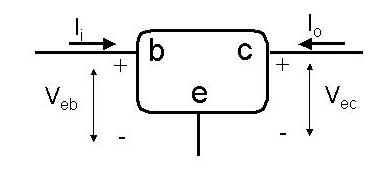
There are three current nodes connected at the terminals. In terms of
the y-parameters we may write,
Ii = yiVeb + yrVec
Io = yfVeb + yoVec
We need to rewrite these for each of the current nodes connected at b,
e and c. Consider the base, b. The current Ii into the base
can be rewritten,
Ii = (yi + yr)Veb -
yrVcb
where the voltages are from e,c to b, the base and follow our previous
conventions. This means that the current into the base effectively
flows to both the emitter and the collector as if there were simple
impedances connected between them. Consider the collector, c. The
current Io into the collector can be rewritten,
Io = (yo + yf)Vec -
yfVbc
For the emitter node we have to compute the current flowing into the
emitter. This current is Ie = -(Ii +
Io). Finally,
Ie = (yi + yf)Vbe +
(yr + yo)Vce
4.2 Transformers
A transformer is simply a four port device as follows.
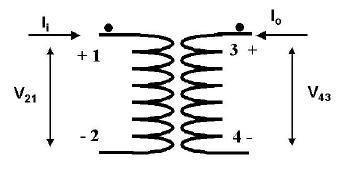
The basic equations of the transformer are,
V21 = jω L1Ii + jω MIo
V43 = jω MIi + jω L2Io
where L1 is the primary (1 - 2) inductance, L2
is the secondary (3 - 4) inductance and M = κ
(L1L2)1/2 is the mutual
inductance. κ is the coefficient of coupling.
The following equations therefore hold,
Ii = yiV21 + yMV43
Io = yMV21 + yoV43
where,
yi = jω L2/(ω 2(M2-L1L2))
yo = jω L1/(ω 2(M2-L1L2))
yM = -jω M/(ω 2(M2-L1L2))
Along the same lines as with the transistor model, the node currents
can be written as,
NODE 1
Ii = yiV21 +
yMV41 - yMV31
NODE 2
-Ii = yiV12 +
yMV32 - yMV42
NODE 3
Io = yoV43 +
yMV23 - yMV13
NODE 4
-Io = yoV34 +
yMV14 - yMV24
As required by our sign convention these equations are written with
the subscript of the node appearing last. The negative currents
appearing at nodes 2 and 4 arise because of the fact that the current
must in reality enter these ports as it does for nodes 1 and 3.
4.3 Transmission Lines
Transmission lines are obviously an important component to model at RF
and will allow us to treat transmission line transformers as well. As
the following figure shows, they are four port devices just like
transformers.
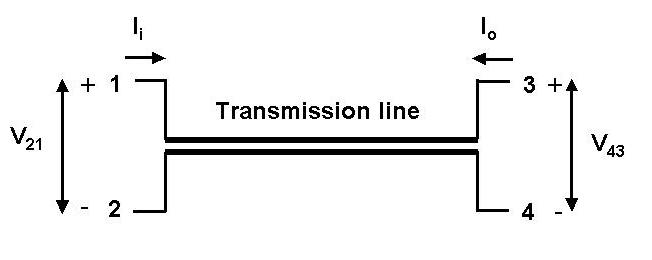
The following y-parameter equations describe the transmission line.
Ii = yiV21 + yTV43
Io = yTV21 + yoV43
where,
yi = 1/jZotan(β l)
yo = yi
yT = -1/jZosin(β l)
where β is the propagation factor and l is the
length of the line. After transformers, we obtain,
NODE 1
Ii = yiV21 +
yTV41 - yTV31
NODE 2
-Ii = yiV12 +
yTV32 - yTV42
NODE 3
Io = yoV43 +
yTV23 - yTV13
NODE 4
-Io = yoV34 +
yTV14 - yTV24
There is one small problem with the above
formulation for transformers and transmission lines. The network
formulation of SOLVE requires that there be one node connected to one
earth yet both transmission lines and transformers have floating
inputs and outputs. Only the input or the output can be directly
connected to earth. Moreover one often wants to float the output. The
solution is to connect a large value resistor from the output earth to
the earth, where by large we mean much larger than the magnitude of
the impedances in the system.
EXAMPLES
To put these ideas into practice and to give an example of how to
treat the transistor, we look at a simple example for the transformer
and a more complex example for transmission lines.
(1) Consider the following 1:1 transformer.
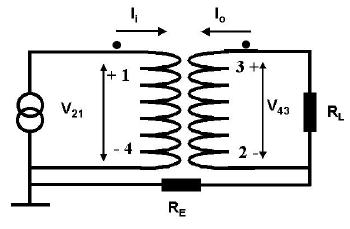
The following matlab program can be run with solve.m to analyse the circuit for Nvals = 300
frequencies from 10 to 1000 MHz. Note the use of RE = 1
MΩ resistor to connect the primary and secondary
earths together. There are N = 4 circuit nodes and only N by N-1 y's
are required (i.e. we ignore the direction from every node to ground).
clear all
%Need to provide Nvals... the number of frequency points
Nvals = 300;
N = 4;
y = zeros(N,N-1,Nvals);
frequency = linspace(1.e7,1.e9,Nvals);
omega = 2*pi*frequency;
RL = 50.;
RE = 1.e6;
cc = 3.e8;
L = 1.e-6;
M = 9.99e-7;
beta = 2*pi*frequency/cc;
yi = (j*omega*L)./(omega.^2*(M^2 - L^2));
yT = -(j*omega*M)./(omega.^2*(M^2 - L^2));
y(4,1,:) = yi;
y(3,1,:) = -yT;
y(2,1,:) = yT;
y(3,2,:) = yi + 1/RL;;
y(4,2,:) = -yT + 1/RE;
y(1,2,:) = yT;
y(2,3,:) = yi + 1/RL;
y(1,3,:) = -yT;
y(4,3,:) = yT;
The main terms of importance are the y's, with the current souce
connected to node 1 and the N = 4 node at ground. Looking at the
definitions of the admittances for the transformer in section 4.2
above, the coefficients of the voltages give the admittance values. In
the case of y(3,2,:) and y(2,3,:), there is also the load resistance.
In the case of y(4,2,:) there is the secondary earth resistor.
(2) The following 4:9 Guanella balun looks pretty
scary from the algebra point of view. The balun is OK for about a 1:2
match independent of frequency. This is because it obeys the phase
lag principle from input to output. The aim is to find the input
impedance.
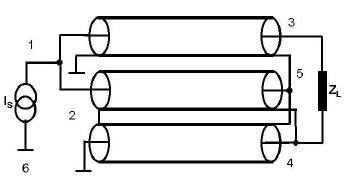
For such a balun to function correctly, it can be shown that the
characteristic impedance of the transmission lines must be given by
(ZSZL)1/2. Since ZS =
50Ω and ZL = 9/4ZS =
112.5 Ω , Zo = 75Ω .
The following MATLAB code does the job.
clear all
%Need to provide Nvals... the number of frequency points
Nvals = 300;
N = 6;
y = zeros(N,N-1,Nvals);
frequency = linspace(1.e7,1.e9,Nvals);
omega = 2*pi*frequency;
ZL = 112.5;
RE = 1.e6;
cc = 3.e8;
Zo = 75.
l = 1.;
beta = 2*pi*frequency/cc;
yi = 1./(j*Zo*tan(beta*l));
yT = -1./(j*Zo*sin(beta*l));
y(6,1,:) = yi;
y(2,1,:) = yi;
y(3,1,:) = -yT;
y(4,1,:) = yT;
y(5,1,:) = yT - yT;
y(6,2,:) = yi;
y(1,2,:) = yi;
y(1,3,:) = -yT;
y(4,3,:) = 1/ZL;
y(5,3,:) = yi;
y(6,3,:) = yT;
y(1,4,:) = yT;
y(3,4,:) = 1/ZL;
y(2,4,:) = yT - yT;
y(5,4,:) = 2*yi;
y(6,4,:) = -yT + 1/RE;
y(3,5,:) = yi;
y(4,5,:) = 2*yi;
y(2,5,:) = yT - yT;
y(6,5,:) = yT - yT;
y(1,5,:) = yT - yT;












